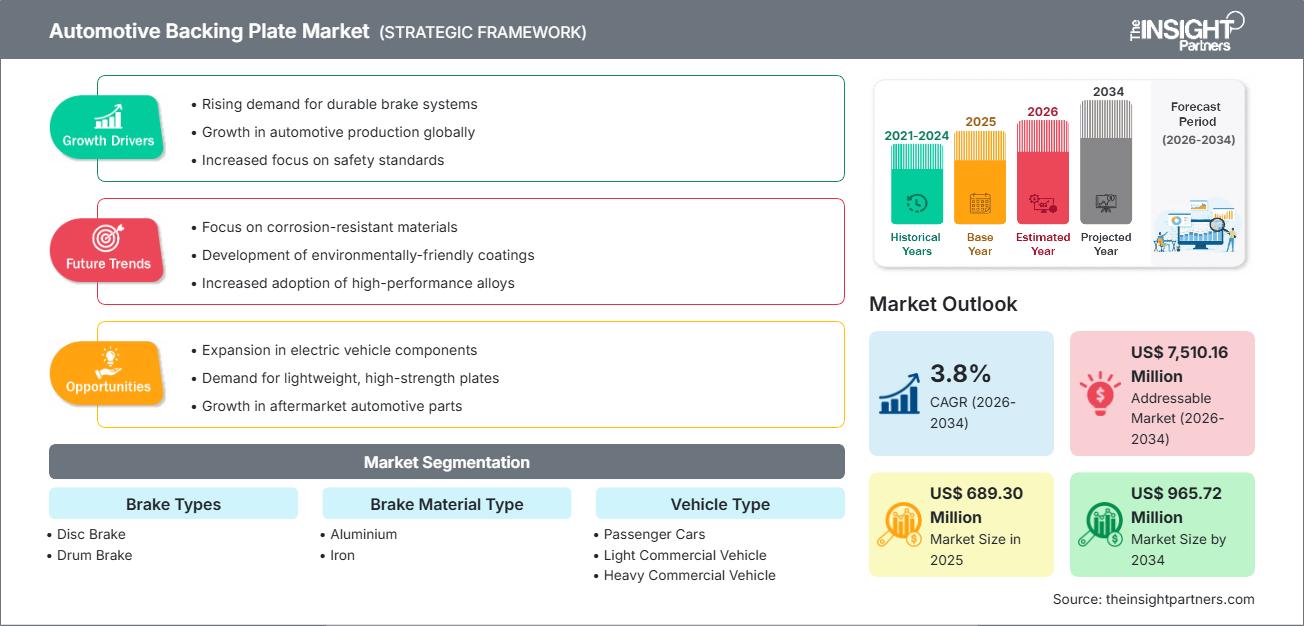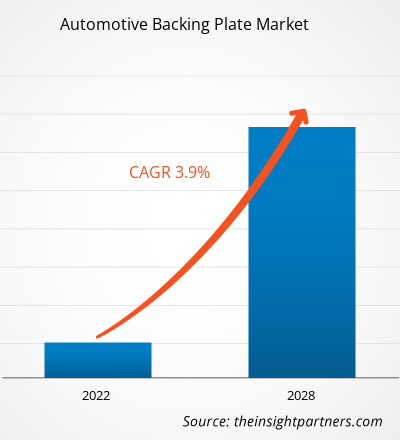Der Markt für Trägerplatten in der Automobilindustrie wird bis 2034 voraussichtlich ein Volumen von 965,72 Millionen US-Dollar erreichen, gegenüber 689,30 Millionen US-Dollar im Jahr 2025. Es wird erwartet, dass der Markt im Zeitraum 2026–2034 eine durchschnittliche jährliche Wachstumsrate (CAGR) von 3,8 % verzeichnen wird.
Marktanalyse für Kfz-Trägerplatten
Der Markt für Bremsankerplatten im Automobilbereich verzeichnet ein stetiges Wachstum, vor allem getrieben durch die steigende globale Fahrzeugproduktion und die strengen Sicherheitsvorschriften, die fortschrittliche Bremssysteme vorschreiben. Die Ankerplatte ist ein wichtiges Bauteil von Scheiben- und Trommelbremsen, das die Bremskomponenten stützt und vor Umwelteinflüssen schützt. Zu den wichtigsten Trends zählt die Hinwendung zu Leichtbaumaterialien wie Verbundwerkstoffen und Aluminium, um Kraftstoffverbrauch und Bremsleistung zu verbessern. Darüber hinaus verändert die zunehmende Verbreitung von Elektrofahrzeugen (EVs) den Markt, da EVs spezielle Ankerplatten für die regenerative Bremsung und das besondere Wärmemanagement benötigen.
Marktübersicht für Kfz-Trägerplatten
Die Ankerplatte ist ein wesentlicher Bestandteil der Bremsanlage eines Fahrzeugs und bildet die notwendige, stabile Basis für die Befestigung anderer Bremskomponenten, wie z. B. Bremsbeläge (bei Scheibenbremsen) oder Bremsbacken (bei Trommelbremsen). Bei Scheibenbremsen sorgt sie dafür, dass der Bremsbelag am Bremssattelkolben anliegt. Bei Trommelbremsen hält die Ankerplatte den Radbremszylinder und die Bremsbacken.
Passen Sie diesen Bericht Ihren Anforderungen an.
Sie erhalten eine kostenlose Anpassung aller Berichte – einschließlich Teilen dieses Berichts, Länderanalysen und Excel-Datenpaketen – sowie attraktive Angebote und Rabatte für Start-ups und Universitäten.
Markt für Kfz-Trägerplatten: Strategische Einblicke

-
Ermitteln Sie die wichtigsten Markttrends dieses Berichts.Diese KOSTENLOSE Probe beinhaltet eine Datenanalyse, die von Markttrends bis hin zu Schätzungen und Prognosen reicht.
Markttreiber und Chancen für Trägerplatten im Automobilsektor
Markttreiber:
- Steigende Fahrzeugproduktion und wachsender Fahrzeugbestand: Der kontinuierliche Anstieg der weltweiten Produktion und des Absatzes von Neufahrzeugen, insbesondere in Schwellenländern, treibt die Nachfrage nach werkseitig verbauten Trägerplatten direkt an. Gleichzeitig beflügelt der wachsende weltweite Fahrzeugbestand (Anzahl zugelassener Fahrzeuge) den Ersatzteilmarkt, da Fahrzeuge mit zunehmendem Alter Ersatzteile benötigen.
- Strenge Fahrzeugsicherheitsvorschriften: Globale und regionale Vorgaben, wie die EU-Allgemeine Sicherheitsverordnung, die fortschrittliche Notbremssysteme vorschreibt, und die aktualisierten US-amerikanischen NHTSA Federal Motor Vehicle Safety Standards, zwingen die Hersteller dazu, fortschrittliche Hochleistungs-Trägerplatten zu verwenden, die strenge Bremsleistungskriterien erfüllen.
- Steigende Nachfrage nach Ersatzteilen: Trägerplatten unterliegen mit der Zeit Verschleiß und Korrosion, was zu einer starken und wachsenden Nachfrage im Ersatzteilmarkt führt. Dieser kontinuierliche Bedarf an Ersatz und Wartung trägt wesentlich zur Marktstabilität und zum Umsatz bei.
Marktchancen:
- Die zunehmende Verbreitung von Elektrofahrzeugen (EVs) erfordert spezielle Trägerplatten, die mit regenerativen Bremssystemen kompatibel sind. Diese Entwicklung bietet Herstellern eine lukrative Chance, fortschrittliche, leichtere und robustere Trägerplatten aus Verbundwerkstoffen oder Aluminium speziell für EV-Plattformen zu entwickeln und anzubieten.
- Fokus auf Leichtbaumaterialien: In der Branche besteht ein anhaltender Trend zur Gewichtsreduzierung von Fahrzeugen, um den Kraftstoffverbrauch (bei Verbrennern) zu senken und die Reichweite (bei Elektrofahrzeugen) zu erhöhen. Hersteller haben die Chance, diesen Trend zu nutzen, indem sie mit fortschrittlichen Leichtbaumaterialien wie Aluminium und Verbundwerkstoffen innovative Lösungen entwickeln und so herkömmliche Trägerplatten aus gestanztem Stahl oder Gusseisen ersetzen.
- Technologische Integration in Bremssysteme: Die Integration elektronischer Komponenten, wie z. B. Sensoren für das Antiblockiersystem (ABS) und die elektronische Bremskraftverteilung (EBD), schafft Möglichkeiten für Trägerplattenkonstruktionen, die diese fortschrittlichen Sicherheitsmerkmale nahtlos integrieren.
Marktbericht für Kfz-Trägerplatten: Segmentierungsanalyse
Der Marktanteil von Trägerplatten für die Automobilindustrie wird in verschiedenen Segmenten analysiert, um ein besseres Verständnis seiner Struktur, seines Wachstumspotenzials und der sich abzeichnenden Trends zu ermöglichen. Nachfolgend ist der in den meisten Branchenberichten verwendete Standard-Segmentierungsansatz dargestellt:
Nach Bremsentyp:
- Scheibenbremse: Sie dient primär dazu, das Bremsbelagmaterial zu befestigen und gegen den Bremssattelkolben abzustützen. Das größte Marktsegment wird durch die weitverbreitete Verwendung von Scheibenbremsen in Pkw bestimmt.
- Trommelbremse: Ein zentrales Bauteil, das den Radzylinder und die Bremsbacken in einer Trommelbremsanordnung verankert.
Nach Fahrzeugtyp:
- Personenkraftwagen: Das größte Marktsegment aufgrund des höchsten Produktions- und Absatzvolumens.
- Leichte Nutzfahrzeuge: Dazu gehören Pickups und Lieferwagen.
- Schwere Nutzfahrzeuge: Die Nachfrage ist an Logistik und industrielle Aktivitäten gekoppelt.
Nach Materialart:
- Eisen: Traditionelles und kostengünstiges Material, das immer noch weit verbreitet ist.
- Aluminium: Wachsende Segmente, die durch den Bedarf an leichten und verbesserten Wärmemanagementlösungen angetrieben werden, insbesondere bei Hochleistungs- und Elektrofahrzeugen.
Nach Geographie:
- Nordamerika
- Europa
- Asien-Pazifik
- Süd- und Mittelamerika
- Naher Osten und Afrika
Regionale Einblicke in den Markt für Trägerplatten im Automobilsektor
Die regionalen Trends und Einflussfaktoren auf den Markt für Trägerplatten in der Automobilindustrie während des gesamten Prognosezeitraums wurden von den Analysten von The Insight Partners eingehend erläutert. Dieser Abschnitt behandelt außerdem die Marktsegmente und die geografische Verteilung des Marktes für Trägerplatten in Nordamerika, Europa, dem asiatisch-pazifischen Raum, dem Nahen Osten und Afrika sowie Süd- und Mittelamerika.
Berichtsumfang zum Markt für Kfz-Trägerplatten
| Berichtattribute | Details |
|---|---|
| Marktgröße im Jahr 2025 | 689,30 Millionen US-Dollar |
| Marktgröße bis 2034 | 965,72 Millionen US-Dollar |
| Globale durchschnittliche jährliche Wachstumsrate (2026 - 2034) | 3,8 % |
| Historische Daten | 2021-2024 |
| Prognosezeitraum | 2026–2034 |
| Abgedeckte Segmente |
Nach Bremsentypen
|
| Abgedeckte Regionen und Länder |
Nordamerika
|
| Marktführer und wichtige Unternehmensprofile |
|
Marktdichte der Akteure im Automobil-Trägerplattenmarkt: Auswirkungen auf die Geschäftsdynamik verstehen
Der Markt für Trägerplatten in der Automobilindustrie wächst rasant, angetrieben durch die steigende Nachfrage der Endverbraucher. Gründe hierfür sind unter anderem sich wandelnde Verbraucherpräferenzen, technologische Fortschritte und ein wachsendes Bewusstsein für die Vorteile des Produkts. Mit steigender Nachfrage erweitern Unternehmen ihr Angebot, entwickeln innovative Lösungen, um den Kundenbedürfnissen gerecht zu werden, und nutzen neue Trends, was das Marktwachstum zusätzlich beflügelt.

- Verschaffen Sie sich einen Überblick über die wichtigsten Akteure im Markt für Trägerplatten für die Automobilindustrie
Marktanteilsanalyse für Kfz-Trägerplatten nach Regionen
Der asiatisch-pazifische Raum ist der größte und am schnellsten wachsende regionale Markt, während Nordamerika und Europa aufgrund ihrer etablierten Automobilindustrie bedeutende Marktanteile halten. Auch die aufstrebenden Märkte in Süd- und Mittelamerika, dem Nahen Osten und Afrika bieten Anbietern von Trägerplatten zahlreiche ungenutzte Expansionsmöglichkeiten, insbesondere im Ersatzteilmarkt.
Der Markt für Trägerplatten im Automobilbereich weist aufgrund von Faktoren wie Automobilfertigung und Produktqualität in den einzelnen Regionen unterschiedliche Wachstumsverläufe auf. Nachfolgend finden Sie eine Zusammenfassung der Marktanteile und Trends nach Regionen:
-
Nordamerika
- Marktanteil: Besitzt einen bedeutenden Marktanteil, der auf eine ausgereifte Automobilindustrie zurückzuführen ist.
-
Wichtigste Einflussfaktoren:
- Präsenz bedeutender globaler Automobilhersteller und Tier-1-Zulieferer.
- Starker Fokus auf Fahrzeugsicherheitsstandards und fortschrittliche Bremstechnologien.
- Trends: Hohe Nachfrage nach hochwertigen und leistungsstarken Trägerplatten; erhebliche Wachstumschancen im Zusammenhang mit der steigenden Produktion von Elektrofahrzeugen.
-
Europa
- Marktanteil: Verfügt über einen starken Marktanteil, der durch eine robuste Automobilproduktionsbasis gestützt wird.
-
Wichtigste Einflussfaktoren:
- Strenge Umwelt- und Sicherheitsvorschriften (z. B. die EU-Allgemeine Sicherheitsverordnung) treiben Innovationen bei der Qualität von Bremskomponenten voran.
- Hohe Nachfrage nach hochentwickelten Bremssystemen in Oberklasse-Pkw.
- Trends: Schwerpunkt auf Leichtbaumaterialien und kupferarmen oder kupferfreien Reibmaterialien, was sich auf die Konstruktion und Produktion der Trägerplatte auswirkt.
-
Asien-Pazifik
- Marktanteil: Besitzt den größten Marktanteil und ist der am schnellsten wachsende regionale Markt.
-
Wichtigste Einflussfaktoren:
- Rasantes Wachstum bei der Fahrzeugproduktion und dem Fahrzeugabsatz, insbesondere in China, Indien und Südostasien.
- Steigende verfügbare Einkommen und eine rasante Urbanisierung führen zu einem vermehrten Fahrzeugbesitz.
- Trends: Hohe Nachfrage im Ersatzteilmarkt aufgrund eines großen und schnell wachsenden Fahrzeugbestands; verstärkter Fokus auf die Lokalisierung der Fertigung.
-
Süd- und Mittelamerika
- Marktanteil: Aufstrebende Regionen mit zunehmender Akzeptanz.
-
Wichtigste Einflussfaktoren:
- Zunehmende Motorisierungsrate und schrittweise Modernisierung der Straßeninfrastruktur.
- Ausbau der lokalen Montage- und Fertigungskapazitäten.
- Trends: Stärkere Abhängigkeit vom Aftermarket-Segment und eine allmähliche Verlagerung hin zu modernen Bremstechnologien.
-
Naher Osten und Afrika
- Marktanteil: Aufstrebender Markt mit starkem Wachstumspotenzial, vor allem getrieben durch das Segment der volumenstarken Ersatzteile (Aftermarket) und Initiativen zur Modernisierung der Fahrzeugflotte in den GCC-Staaten (VAE, Saudi-Arabien) und Südafrika.
-
Wichtigste Einflussfaktoren:
- Die rauen klimatischen Bedingungen (extreme Hitze, Staub) und die oft schwierigen Straßenverhältnisse beschleunigen den Verschleiß der Bremskomponenten und führen zu einer hohen und zuverlässigen Nachfrage nach Ersatz-Trägerplatten.
- Trends: Nachfrage nach korrosionsbeständigen Beschichtungen und langlebigen Metallplatten, die den rauen Umgebungsbedingungen standhalten.
Marktdichte der Akteure im Automobil-Trägerplattenmarkt: Auswirkungen auf die Geschäftsdynamik verstehen
Der Markt für Bremsankerplatten im Automobilbereich zeichnet sich durch eine Mischung aus spezialisierten Herstellern und großen, globalen Tier-1-Zulieferern innerhalb der breiteren Automobilbremsanlagenindustrie aus. Der Wettbewerb ist intensiv und konzentriert sich auf Produktqualität, Materialinnovationen und die Einhaltung strenger Industriestandards.
Der Wettbewerb zwingt die Anbieter dazu, sich durch Folgendes zu differenzieren:
- Unternehmen investieren stark in Forschung und Entwicklung, um Trägerplatten aus Aluminium oder Verbundwerkstoffen zu entwickeln, mit denen eine Gewichtsreduzierung und eine bessere Wärmeleistung erzielt werden sollen.
- Die Zulieferer gehen in Richtung integrierter Eckmodule und kompletter Bremssystemlösungen, was erfordert, dass die Trägerplatten so konstruiert sind, dass sie sich nahtlos in moderne ABS/EBD-Systeme integrieren lassen.
- Zulieferer im Aftermarket konkurrieren durch das Angebot umfangreicher Produktkataloge, die eine breite Palette von Fahrzeugmarken und -modellen abdecken, wobei der Fokus auf qualitativ hochwertigen Ersatzteilen zu wettbewerbsfähigen Preisen liegt.
Chancen und strategische Schritte
- Die wichtigsten Akteure tätigen strategische Investitionen, um Trägerplatten zu entwickeln und herzustellen, die speziell auf die besonderen Anforderungen von Elektrofahrzeugen zugeschnitten sind, darunter Geräuschentwicklung, Gewicht und Wärmemanagement.
- Die Zusammenarbeit zwischen Materiallieferanten, Tier-1-Herstellern und OEMs ist entscheidend für die Entwicklung und Validierung neuer Materialien und Designs, die in Serie produziert werden können und gleichzeitig strenge Sicherheits- und Leistungsstandards erfüllen.
- Die Anbieter bauen ihre Produktions- und Vertriebskapazitäten aktiv in wachstumsstarken Regionen wie dem asiatisch-pazifischen Raum aus, um sich OEM-Lieferverträge zu sichern und einen größeren Anteil am boomenden Ersatzteilmarkt zu erobern.
Die wichtigsten Unternehmen auf dem Markt für Kfz-Trägerplatten sind:
- Superkreis
- NUCAP
- MAT Foundry Group Ltd.
- INDUS Marmara Auto Components Pvt Ltd.
- Dorman Produkte
- Ridex GmbH
- ORTLINGHAUS-WERKE GmbH
- Sparex
- RSB Tech Solution
Hinweis: Die oben aufgeführten Unternehmen sind nicht in einer bestimmten Reihenfolge geordnet.
Neuigkeiten und aktuelle Entwicklungen auf dem Markt für Trägerplatten im Automobilbereich
- So kündigte Dorman Products, Inc. beispielsweise im Oktober 2024 die Markteinführung hunderter neuer Ersatzteile und Baugruppen an und erweiterte damit seinen umfangreichen Katalog mit über 133.000 Artikeln. Viele dieser Neuheiten sind exklusiv im Ersatzteilmarkt erhältlich und bieten innovative Lösungen, die dazu beitragen, dass Fahrzeuge im Alltag einsatzbereit bleiben und gleichzeitig Teilehändlern, Einzelhändlern und Werkstätten Millionen von Reparaturmöglichkeiten eröffnen.
- Im November 2022 kündigte Dorman Products, Inc. die Markteinführung von über 300 neuen Kfz-Teilen an, von denen die Hälfte exklusiv im Aftermarket erhältlich ist. Die neuen Produkte unterstützen Dormans Ziel, Reparaturfachleuten und Fahrzeughaltern mehr Flexibilität bei der Reparatur von Pkw, Nutzfahrzeugen und Freizeitfahrzeugen mit Verbrennungs-, Hybrid- und Elektroantrieb zu bieten.
Marktbericht zu Trägerplatten für die Automobilindustrie: Abdeckung und Ergebnisse
Der Bericht „Marktgröße und Prognose für Kfz-Trägerplatten (2021–2034)“ bietet eine detaillierte Analyse des Marktes, die folgende Bereiche abdeckt:
- Marktgröße und Prognose für Trägerplatten im Automobilsektor auf globaler, regionaler und Länderebene für alle wichtigen Marktsegmente, die im Geltungsbereich abgedeckt werden
- Trends im Markt für Trägerplatten in der Automobilindustrie sowie Marktdynamiken wie Treiber, Hemmnisse und wichtige Chancen
- Detaillierte PEST- und SWOT-Analyse
- Marktanalyse für Trägerplatten im Automobilsektor: Wichtige Markttrends, globale und regionale Rahmenbedingungen, Hauptakteure, regulatorische Rahmenbedingungen und aktuelle Marktentwicklungen
- Branchenlandschaft und Wettbewerbsanalyse mit Marktkonzentration, Heatmap-Analyse, führenden Akteuren und aktuellen Entwicklungen im Markt für Trägerplatten für die Automobilindustrie. Detaillierte Unternehmensprofile.
- Historische Analyse (2 Jahre), Basisjahr, Prognose (7 Jahre) mit CAGR
- PEST- und SWOT-Analyse
- Marktgröße Wert/Volumen – Global, Regional, Land
- Branchen- und Wettbewerbslandschaft
- Excel-Datensatz
Aktuelle Berichte
Erfahrungsberichte
Grund zum Kauf
- Fundierte Entscheidungsfindung
- Marktdynamik verstehen
- Wettbewerbsanalyse
- Kundeneinblicke
- Marktprognosen
- Risikominimierung
- Strategische Planung
- Investitionsbegründung
- Identifizierung neuer Märkte
- Verbesserung von Marketingstrategien
- Steigerung der Betriebseffizienz
- Anpassung an regulatorische Trends






















 Kostenlose Probe anfordern für - Automobil-Trägerplattenmarkt
Kostenlose Probe anfordern für - Automobil-Trägerplattenmarkt